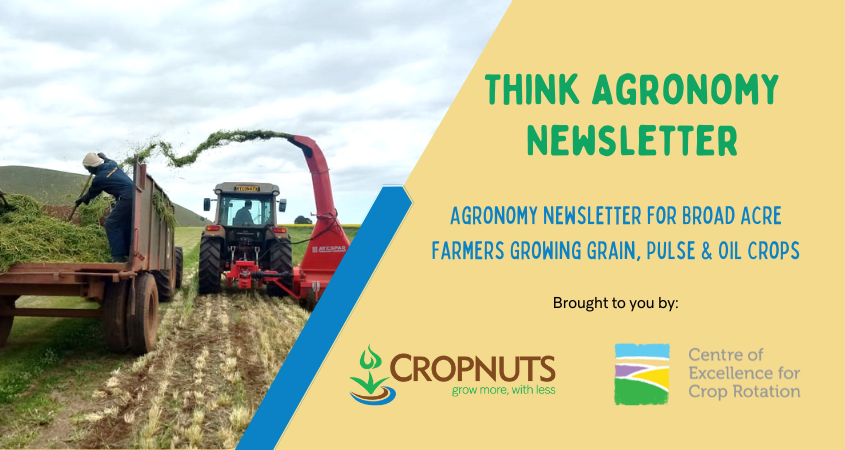
Easy to establish and reliable, maize produces a very palatable and high-energy silage provided that it is well chopped and ensiled properly. Typically over 11 Mj of metabolisable energy per kilo, it is a great way of storing crop to feed for livestock later. The main drawbacks are that it needs to be harvested in a narrow window; too early and it is very acidic so animal intake will be low, energy content below optimum and a lot of effluent will be produced. Protein content is also very low.
Avoid harvesting too late otherwise digestibility will drop and animal performance will decline, as well as being hard to clamp and store successfully. And remember that harvest could be 6-8 weeks earlier than a grain crop, so plan planting date to coincide with a dry harvest (avoid November or April around Meru!)

Lucerne makes great silage, and once established provides years of good-quality cuts. The text books say 3-4 years, but I have seen some of the best-performing Lucerne crops approaching 7 years old. A crop will produce silage well over 20% protein, but cutting and wilting needs care; leave 7cm of stubble for quick regrowth, and wilt down to 30-40% dry matter (do not leave it too long as the crop is liable to shatter and loose the leaf).
Lucerne still wants to be cut fairly fine with a 4-5cm chop length, but provided it is cut and wilted properly to concentrate the sugar, a well-rolled clamp will store successfully. Remember that Lucerne prefers higher pH soils, so soil test a paddock if planning to spend the money establishing a crop.
Probably the most common forage. Without doubt, the poorest quality product for feeding livestock, it is very rare to see a sample higher with an energy content above 10 ME, and fibre is often very high because of the stemmy nature of the plant. Difficult and slow to establish, the positives with Rhodes grass is that it is reliable at least across a lot of different environments and can survive a dry period well.
Rhodes also has plenty of options for cutting, grazing, silage and hay, making it very versatile, however in higher rainfall areas it is an enormous missed opportunity in both volume of feed and quality, compared to an oat hay, ryegrass or sorghum / sudan grass type crop.
A little grown crop here, but varieties are becoming available. Ironically ryegrass is a huge weed problem on the Mau and on the edges of the Rift Valley, but day-length dependent varieties will not go to seed and actually provide a way to cut and prevent seed set in areas where it is a problem. There is certainly proof that it grows successfully here!
Established like Rhodes grass, ryegrass can be grazed and cut successfully, and when planted with clover requires a lot less nitrogen and produces a much higher protein content forage. Ryegrass does require well-distributed rainfall, but fast annual types are also available which could be planted in March/April to provide 3 cuts of silage, before spraying off in December and planting a different crop the following year. Exceptional protein and energy content, easy to mechanise but needs cool and rain.
Forage sorghums and sorghum x sudan grasses were totally new to me a few years ago, but having seen Stuart Barden at Ausquest and the quality of forage that he produces, it has really opened my eyes to a fast, high energy and protein, easy-to-feed product that thrives in warmer areas where maize is too slow and it is too hot for cereals.
It does require good planting and a relatively specialist kit to properly wilt and chop the material, but if done well it is a unique forage, akin to a ryegrass crossed with maize!
Some of the best yields of forage I have seen are from wholecrop silage mixes of cereals and legumes. Planting a mix of barley and peas for example, allows you to spray with pendimethalin pre-emergence and then follow with bentazone post-emergence, where approved for the crop, and gives a wonder high energy, high protein forage capable of producing 50 t/ha from a single cut.

Oats and Vetch have fewer weed control options but are also good companions, albeit they tend to lodge a bit more with wet weather near harvest. Cereal rye is a great companion that sacrifices a bit of energy and intake potential for even high yields and drought tolerance.
A great crop which is easy to establish with simple cereal equipment and with many weed control options. Cut for hay at the milky ripe stage, or earlier for silage, oats are very palatable, hardy and aggressive with plenty of herbicide and weed control options (plus when cut for silage they normally regrow enough to graze with livestock or provide ground cover before another crop can be planted).
It has been a few years since we looked at maize fungicides in trials. There is undoubtedly an economic response in most crops, but it varies significantly according to region, variety and previous cropping.
Looking to other parts of the world there is a substantial amount of work done every year. In the Corn Belt in the United States, a 200-bushel/acre (55 bags per acre) crop usually sees a 10% yield benefit from a fungicide post-flowering.
I tend to see a lot less disease around Nakuru, Naivasha and Meru (Kenya) and it tends to be largely Leaf Rust. There are exceptions to this but they tend to be thick crops, in wet seasons, planted into maize residue where there is a lot of inoculum.

Kenya’s North Rift always surprises me with how much more Northern Corn Leaf Blight (NCLB) and especially Gray Leaf Spot – both of which tend to be more damaging to yield.
H614, SY594 and Twiga 83 are all highly susceptible to Gray Leaf Spot, whilst Pannar 691, H6213 and 6218 tend to be a lot cleaner. Azoxystrobin, tebuconazole and propiconazole are weak on NCLB so don’t get caught out. Pyraclostrobin is much stronger where NCLB is expected.
Northern Corn Leaf Blight tends to show up in DK 777 relatively early, but there appears to be less reliable varietal resistance to this, however, most Kenya Seed varieties tend to be more resistant. Azoxystrobin and Pyraclostrobin offer the best control of NCLB.
DK8033 and P3812W are the ultimate worst varieties for Leaf Rust, which require relatively early intervention at around the 5-6 collar stage. Anything with azoxystrobin or pyraclostrobin provides good protection, but a second fungicide is required in these varieties at the very minimum.
Like many things in our world, there are complex interactions beyond our comprehension and understanding which blindside and humble us. Having looked at the soil test results when I arrived six years ago on most of the farms I visit, I was amazed that they were not liming with pH’s commonly below 6.
Then after putting down some areas of lime in fields to observe, I came to realise that there was not an immediate or obvious difference where the lime had been applied. Low exchangeable aluminium and manganese in our soils? High organic matter buffering these effects (I used to deal with several farms that had manganese lock up in high organic matter areas on their farms – as soon as you got to areas of field below 3% OM, the manganese became available and the problem went away).
So, we – or at least I – parked the problem and forgot about it for a few years. Until we started to explore ways to improve phosphorus availability and to create a better environment for earthworms in our soils (the Acrisols on the Northern slopes of Mount Kenya are notoriously dense and devoid of earthworm channels).
Back in October 2022, six months before we planted this season’s trials, we applied 3 t/ha of good quality lime in an area of our trial sites to give it time for the neutralising to take place.
Then in April we planted different rates of phosphate on the limed area, and right next to it where we did not apply lime…

Visually the limed plots are a lot stronger – the crop emerged a day earlier and has been a lot more vigorous. But what we did not expect was the effect that it appears to have had on phosphorus availability. The improvement in vigour as P rate increases is obvious in the non-limed area, but all of the plots looks the same where we limed!
Then comes the second curveball. The last four soil tests on this site have been over 40ppm of P (three of which over 80ppm!) so the site should not be short of P. Leaf tests are showing higher P levels from the liming, so is this a pH effect we are observing or a P fixation effect? Who knows.
The most salient lesson for all of this is to keep an open mind and to keep learning by doing.
Till next time,
David Jones
Independent Agronomist
Think Agronomy is brought to you by Cropnuts and the Centre of Excellence for Crop Rotation. We share the same vision for sustainable, dryland farming across Africa, and Think Agronomy is our independent voice to promote profitable, climate-resilient farming through better management of soil health, systems-based agronomy, crop diversification, and farm mechanization.
How would you rate this article? Click link

David is an independent agronomist in Kenya and a member of the Association of Independent Crop Consultants. David gives independent advice based on scientific trials and experience. Currently works with the Centre of Excellence for Crop Rotation. Follow him on Twitter @Kenya_agron
Order our services and get to know how to improve your soil for better yeilds.